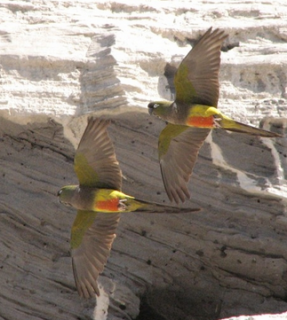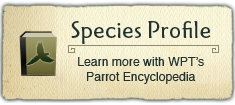Project Regions:
Patagonian Conure |
|
|
Collaborators/Funders
Max Planck Institute of Ornithology, Wild Fauna Division of the province of Rio Negro, Fundación Patagonia Natural (FPN)
Unique burrowing parrot heavily persecuted
Patagonian Conure (Cyanoliseus patagonus) populations are declining due to ongoing habitat destruction and unsustainable levels of exploitation.
Progress and outcomes: Since 1998, researcher Dr. Juan Massello and his team have conducted studies of the breeding biology of Patagonian Conures, at the species' largest and most important colony in Argentina. WPT has funded studies into the birds' geographic distribution, its conservation status in Argentina and Chile and how ecological and climatic factors influence the population. WPT has also been supporting protection of nesting colonies and other habitat crucial to the species. In 2003 Dr. Massello contacted the World Parrot Trust when his team's work with the Patagonian Conure was interrupted due to lack of funds. The researchers' presence has protected the largest cliff-nesting colony of these birds, and when they stopped work, poachers moved in to collect nestlings. WPT stepped in and provided help.
In 2004 meetings were held with organisations and the researchers to coordinate a joint conservation programme for the largest known parrot colony. One of the ideas that arose from this congress was an educational campaign for the people and ecotourism interests in the region. WPT also funded wardens to protect the Cerro Tololo colony in Chile during the breeding season, beginning in 2010. As a result, “picos blancos” (white bills) were seen flying around the colony. This means that for the first time in years the adults have managed to successfully raise fledglings.
With your help we can complete these important tasks to better understand the species, and continue to deliver effective solutions to further their conservation.
Wild population: About 95,000.
Where found: C.p. patagonus: S Argentina, ranging north in winter to C Argentina and S Uruguay.
C.p. conlara: C Argentina.
C.p. andinus: NW Argentina, from Salta and Catamarca south to C Mendoza and N San Luis.
C.p. bloxami: formerly C Chile, but now restricted to a few localities in central provinces, including Bio Bio.
History: The Patagonian Conure or Burrowing Parrot, Cyanoliseus patagonus, is found in Argentina, Uruguay and Chile. The population and range of this species were last studied at the end of the 1970s and early 1980s. Patagonian Conures were once very common in Argentina, but are now only abundant in certain regions, this since the beginning of the 19th century. Their decline in Argentina is due to increasing persecution as a crop pest, conversion of habitat to agriculture and increased trapping for the wild bird trade (since 1981 122,914 individuals have been traded internationally – UNEP-WCMC CITES Trade Database, Jan. 2005). Factors of its breeding biology contribute to the fragility of the species, particularly its tendency to breed in large and conspicuous colonies. During the 1990s a significant section of one of these colonies was dynamited for the building of a pedestrian path and car park near to a beach at Segunda Bajada del Faro. An estimated 800 nest sites were destroyed. During the breeding season in 2000 – 2001 this access was enlarged. The attendant noise pollution and disruption from people has caused the colony to be highly disrupted, then inactive for subsequent seasons (J. Massello, P. Quillfeldt, PsittaScene, Nov. 2003, May 2004, May 2005).
Burrowing Parrots are also considered an agricultural pest in Argentina. This label remains despite the fact that very little actual crop damage has been measured (less than 1% of claims) and where it occurs it is only in very specific locations. In spite of this they have been traditionally persecuted and as a consequence several colonies have been destroyed or severely reduced in size. Unfortunately this was the fate of the formerly largest known colony of the species, located on the Quequén Salado River, in the province of Buenos Aires. In the mid-1970’s this colony contained some 45,000 nests. Only a few hundred remain today.
Threats:
- Persecution as crop pest
- Poisoning (DDT)
- Heavy trading on international market
- Degradation and destruction of breeding colony
Ecology: The Patagonian Conure forms large flocks in its native Argentina and Chile in excess of 1000 birds, roosting communally in trees, on wires, and in nest tunnels. These sociable birds are seen in open grass country, savanna, wooded valleys with cliffs and farmland to about 2000m (6560 ft). They can also be found in arid country near streams and rivers. Their preferred foods include seeds and fruits, and rarely grain crops. A recent study found over 35,000 active nest burrows for the flocks of El Condor, Patagonia. The counts showed that the colony extended over 9km of a sandstone cliff facing the ocean.
Project Updates
- PsittaScene Vol. 25.3, Autumn 2013
- PsittaScene Vol. 21.1, Feb. 2009
- PsittaScene Vol. 19.4, Nov. 2007
- PsittaScene Vol. 19.3, Aug. 2007
- PsittaScene Vol. 18.2, May 2006
- PsittaScene Vol. 17.4, Nov. 2005
- PsittaScene Vol. 17.2, May 2005
- PsittaScene Vol. 16.2, May 2004
- PsittaScene Vol. 15.3, Nov. 2003
- PsittaScene Vol. 1, Oct. 1989
Other publications:
Google scholar - Cyanoliseus patagonus
Other information:


































